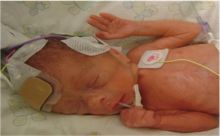2010 Press Releases
29.04.2010
A multidisciplinary team of clinicians, scientists and engineers at UCC has been using EEG (measurements of electrical brain activity) to investigate brain injury and seizures in newborn babies and their invention the EEG Seizure Detection technology has won joint first prize in the inaugural Invention of the Year Awards for UCC research.
The other prizewinning invention was the Variable Barrier Transistor developed by researchers at the Tyndall National Institute at UCC. This invention pushes the boundaries of semiconductor device research.
EEG Seizure Detection
The only accurate technique available for diagnosing all seizures in babies is EEG, which records electrical brain activity using small electrodes placed on the scalp. EEG equipment is expensive and requires highly specialised technical and medical personnel to acquire and interpret the results. Most neonatal units in Europe lack this expertise and have to rely on clinical judgement alone to diagnose seizures, which is known to be inaccurate. "It was therefore imperative that a seizure detection system that was simple to operate, easy to interpret, and that provided reliable accurate information was developed " says Dr Gordon Lightbody of the Department of Electrical & Electronic Engineering. This is what the UCC team has done.
Through SFI and Wellcome Trust funding, the team first developed a signal processing system based on EEG to help medical staff identify seizures in newborn babies without the need for complicated equipment or an expert to interpret the results. “Early detection of seizures will allow prompt and effective treatment and should translate into better long term neurological outcome for the smallest and most vulnerable members of the population,” says Dr Geraldine Boylan, School of Medicine, UCC. This research is important because seizures are more common in the neonatal period than during any other time throughout life. The incidence of seizures in babies born at full term (40 weeks) is 1.5-3.0 per 1,000 births: the incidence is even higher in premature babies, ranging from 50-150 per 1,000 live births. “These figures are probably inaccurate as they only include the seizures that can be observed,” says Dr Boylan.
Dr Liam Marnane and the team of electrical engineers on the project then developed the technology further for adult seizure detection through an SFI Strategic Research Cluster grant. This allowed the group to develop an ambulatory system that allows patients suspected of epilepsy to be monitored in their own home.
The new technology EEG Seizure Detection was a collaboration between UCC’s Department of Electrical & Electronic Engineering and the School of Medicine involving Dr Stephen Faul, Dr Andrey Temko, Dr Liam Marnane, Dr Gordon Lightbody and Dr Geraldine Boylan.
Variable Barrier Transistor
The other prizewinning invention was the Variable Barrier Transistor (VBT) developed by Professor Jean-Pierre Colinge and Dr Aryan Afzalian of the Tyndall National Institute at UCC. This invention pushes the boundaries of semiconductor device research. The VBT is a smaller, faster, more sensitive, and lower power-consuming transistor that leaps beyond the present industry roadmap for competitor technology. Transistors are the basic building block of microelectronics circuits and microprocessor chips (ICs) and, indeed, of all the electronic devices that we use every day, such as mobile phones, MP3 players, wristwatches and game consoles.
The processing power and capability of such systems is directly related to the number of transistors which can fit on the IC chip, and this has steadily risen because of increased transistor numbers which are realisable as devices get smaller. Moore’s Law (1965) stated that the number of transistors per chip would need to double every two years. Moore was the co-founder of Intel and his prediction has become one of the most adhered-to industry roadmaps of all time, being driven by consumer demand for continuous development and improvement.
Physical size limitations of transistors mean the end is nigh for Moore’s law, and all IC research worldwide is focused on finding ways to extend it. If devices cannot be made smaller, then they must become faster, or more efficient, or less power-hungry. The VBT transistor uniquely meets all of these criteria. A patent application has been filed at the US and European Patent Offices.
“This is ground-breaking research by one of the world’s leading transistor device design and fabrication research engineers, and it has enormous commercialisation potential” says Dr Anthony Morrissey of UCC’s Office of Technology Transfer. “It is part of an SFI-funded research programme into nanoelectronics technology, developing the devices which will drive the electronics industry into the next generation and beyond.”
Some VBT transistors have already been produced at the Tyndall National Institute, and early test results and simulations show that the invention can potentially work in sub-nanometre scale devices, thus extending Moore’s Law. The major players in the industry are already engaged with UCC with a view to commercially exploiting the technology.
UCC Technology Transfer
Speaking about the awards, UCC President, Dr Michael Murphy highlighted the large increase in the number of licenses and start-ups companies in UCC: “In 2009, four companies were set up based on our intellectual property and we executed 14 licenses to multinationals and SMEs. Prior to 2007 the rate was approximately five licenses annually and one company formed every second year”.
The President commented that in the university’s Strategic Plan 2009 – 2012 research commercialisation was identified as one of its five strategic goals: “The successes being celebrated with these awards are strong evidence of the implementation of this strategic plan.”
The awards ceremony was sponsored by Ronan Daly Jermyn Solicitors and the Invention of the Year competition was sponsored by Purdy Lucey Intellectual Property.
Picture:
Early detection of seizures in babies will allow prompt and effective treatment
RMcD

